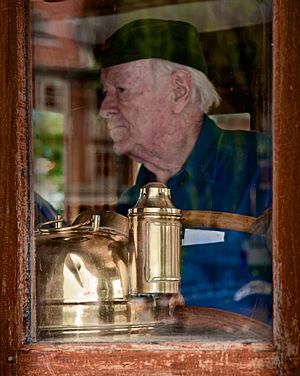William P. Murphy Jr. facts for kids
Quick facts for kids
William P. Murphy Jr.
|
|
|---|---|

Murphy on his 100 ton steam ship, 2013
|
|
| Born |
William Parry Murphy Jr.
November 11, 1923 Boston, Massachusetts, U.S.
|
| Died | November 30, 2023 (aged 100) Coral Gables, Florida, U.S.
|
| Occupation |
|
| Spouse(s) |
|
| Children | 3 |
| Parent(s) | William Parry Murphy Harriett Adams |
William Parry Murphy Jr. (born November 11, 1923, died November 30, 2023) was an American doctor and inventor. He created many important medical devices. One of his key inventions was a flexible, sealed bag for blood transfusions. His father, William Parry Murphy, won a Nobel Prize in Physiology in 1934. His mother, Harriett Adams, was the first licensed female dentist in Massachusetts.
Contents
Early Life and Education
William Parry Murphy Jr. was born in Boston, Massachusetts, on November 11, 1923. His father was a blood doctor named William Parry Murphy. His mother, Harriet Adams Murphy, was the first woman to become a licensed dentist in Massachusetts.
Murphy grew up in Brookline, Massachusetts. He went to Harvard University and graduated in 1946. He studied pre-medicine and also architecture. In 1947, he earned his medical degree (M.D.) from the University of Illinois. He also studied how to use instruments in medicine at the Massachusetts Institute of Technology from 1947 to 1948.
A Career of Medical Inventions
Murphy worked as a doctor for a short time. He interned at St. Francis Hospital in Honolulu and later at Peter Bent Brigham Hospital in Boston. While in Honolulu, he invented his first medical device. It was a projector that could show full-size X-rays to many people at once. This made it much easier for doctors to discuss patient X-rays.
Improving Blood Transfusions
Murphy's next big invention helped during the Korean War. The U.S. Army asked him to work on improving dialysis machines. This was important because of worries about radiation exposure. From this work, Murphy and Carl Walter developed flexible bags for blood transfusions.
Before this, doctors used glass bottles for blood. The new flexible bags were much better. They kept red blood cells and proteins safe. They also made sure the blood was not exposed to air. In 1952, Murphy became a blood transfusion expert for the U.S. Public Health Service. He went to Korea to help injured soldiers with transfusions.
Founding Medical Companies
In 1957, Murphy started his first company, Medical Development Corporation. This company focused on making tools for medical research. It later grew into Cordis Corporation, which is now part of Johnson & Johnson. Cordis helped Murphy create many common medical devices we use today.
These inventions include:
- The first physiologic cardiac pacemaker. This device helps hearts beat normally.
- The widely used hollow fiber artificial kidney. This machine helps clean blood when kidneys don't work.
- The first disposable medical procedural trays. These trays hold all the tools a doctor needs for a procedure.
- The first motor-driven angiographic injectors. These are used to inject special dyes for X-ray images.
- The first disposable catheters. These are thin tubes used to enter blood vessels.
How Pacemakers Evolved
Murphy's first cardiac pacemaker helped hearts with "heart block." It sensed what a patient's heart needed and gave it the right electrical pulses. As more doctors used pacemakers, they needed a way to change how they worked after they were put inside the body.
This led Murphy and his team to create pacemakers that could be programmed from outside the body. Eventually, they developed the first DDD (dual chamber demand) pacemaker in the 1980s. This was a big step forward in heart care.
Better Imaging Tools
Murphy also invented motor-driven, high-pressure angiographic injectors. These devices inject a small amount of special dye into blood vessels. This dye shows up clearly on X-ray images. The images, called angiograms, help doctors see blockages in blood vessels.
He also worked with Robert Stevens to create disposable, torque-controlled vascular catheters. These sterile, single-use tubes make it easy to enter specific blood vessels.
Helping Other Inventors
While at Cordis, Murphy sometimes found it hard to get the right materials for his inventions. To solve this, he started another company called Small Parts, Inc. This company provides materials and tools to engineers in any amount they need. Small Parts, Inc. became well-known in the medical and engineering fields. It was one of many companies that grew from Cordis.
In 1986, Murphy and John Sterner bought Hyperion, Inc. This company designs and sells medical laboratory diagnostic devices.
Murphy was also the chairman of U.S. Stem Cell, a company that used to be called Bioheart. He retired in 2022.
Murphy's Patents
William P. Murphy Jr. held 17 U.S. patents. These patents were issued between 1952 and 1980.
Personal Life
Murphy married Barbara Eastham in 1943. They had three daughters and later divorced in the early 1970s. In 1973, he married Beverly Patterson.
Murphy turned 100 years old on November 11, 2023. He passed away 19 days later, on November 30, at his home in Coral Gables, Florida.
Publications and Organizations
Murphy co-authored nearly 30 medical publications. He also helped start several professional organizations. One important group he helped create is FIRST. This non-profit organization inspires young people to get interested in science, technology, and engineering. It was founded by his friend Dean Kamen.
Medical Licenses
Murphy was licensed to practice medicine in three states:
- California (license #C018494)
- Florida (license #0007401)
- Massachusetts (license #23378)

